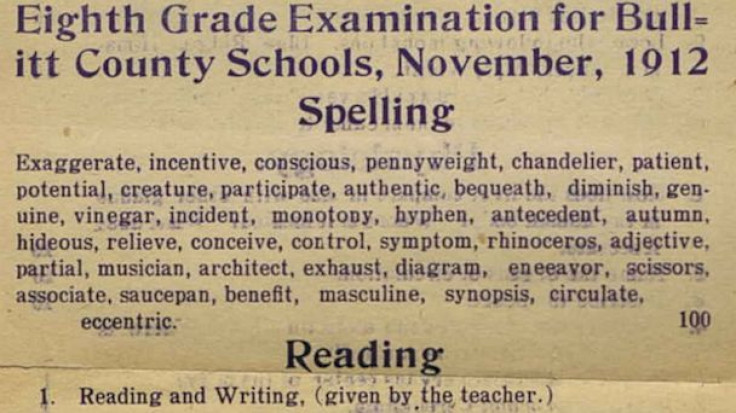1912 Eighth Grade Exam: Could You Pass These 30 Questions Given 101 Years Ago?

A museum in Kentucky found the predecessor to Fox’s “Are You Smarter Than a 5th Grader,” an eighth-grade exam from 1912 that has the web going crazy.
According to ABC News, the Bullitt County History Museum unearthed the test (which you can read in its entirety, here) given to eighth-graders 101 years ago. The exam was split into eight subjects: spelling, reading, arithmetic, grammar, geography, physiology, civil government and history.
Students matriculated in Bullitt County schools gathered at the county courthouse once or twice a year to take the “Common Exam” and received the test in a scroll form. Some students who did well on the exam were given scholarships to high school, which as the site explains, for the time, was a “big deal.”
“For us, this is just fascinating,” volunteer David Lee Strange told ABC News. “It puts us in the mindset of 1912. Some people say that the questions are trivial, but the questions relate to what the children at the time would have been familiar with.”
For example, one question about bordering countries would be no problem for geography-savvy students today. But according to Strange, “the students back then would have to be familiar with that part of the world.”
While the website said the test “should not be used to compare student knowledge then and now,” countless people have taken to the Internet to share their results, which may surprise you.
Are you up for the challenge? Here are 30 of the questions on the exam. You can view the test in its entirety at BullittCountyHistory.com.
Arithmetic
1. Write in words the following: .5764; .000003; .123416; 653.0965; 43.37.
2. Find cost at 12 ½ cents per sq. yd. of kalsomining the walls of a room 20 ft. long, 16 ft. wide and 9 ft. high, deducting 1 door 8 ft. by 4 ft. 6 in. and 2 windows 5 ft. by 3 ft. 6 in. each.
3. A man bought a farm for $2400 and sold it for $2700. What per cent did he gain?
4. A school enrolled 120 pupils and the number of boys was two thirds the number of girls. How many of each sex were enrolled?
5. How long of a rope is required to reach from the top of a building 40 ft. high, to the ground 30 ft. from the base of the building?
Grammar
1. How many parts of speech are there? Define each.
2. What properties have verbs?
3. Diagram: The Lord loveth a cheerful giver.
4. Parse all the words in the following sentence: John ran over the bridge. Helen’s parents love her.
5. “William struck James.” Change the Voice of the verb.
Geography
1. Define longitude and latitude.
2. Name and give the capital of States touching the Ohio River.
3. Name in the order of their size the three largest States in the United States.
4. Locate Erie Canal; what waters does it connect, and why is it important?
5. Locate the following countries and which border each other: Turkey, Greece, Servia, Montenegro, Roumania.
Physiology
1. How does the liver compare in size with other glands in the human body? Where is it located? What does it secrete?
2. Define Cerebrum; Cerebellum.
3. What are the functions (or uses) of the spinal column?
4. Name the organs of circulation.
5. Describe the heart.
Civil Government
1. Name five county officers, and the principal duties of each.
2. Name three rights given to Congress by the Constitution and two rights denied to Congress.
3. Describe the manner in which the president and vice-president of the United States are elected.
4. Give three duties of the President. What is meant by the veto power?
5. What is a copyright? Patent right?
History
1. Who first discovered the following places: Florida, Pacific Ocean, Mississippi River, St. Lawrence River?
2. Name the last battle of the Civil War; War of 1812; French and Indian War and the commanders in each battle.
3. Who invented the following: Magnetic, Telegraph, Cotton Gin, Sewing Machine, Telephone, Phonograph.
4. Describe the Battle of Quebec.
5. Give the case of the War of 1812 and name an important battle fought during that war.
© Copyright IBTimes 2024. All rights reserved.












